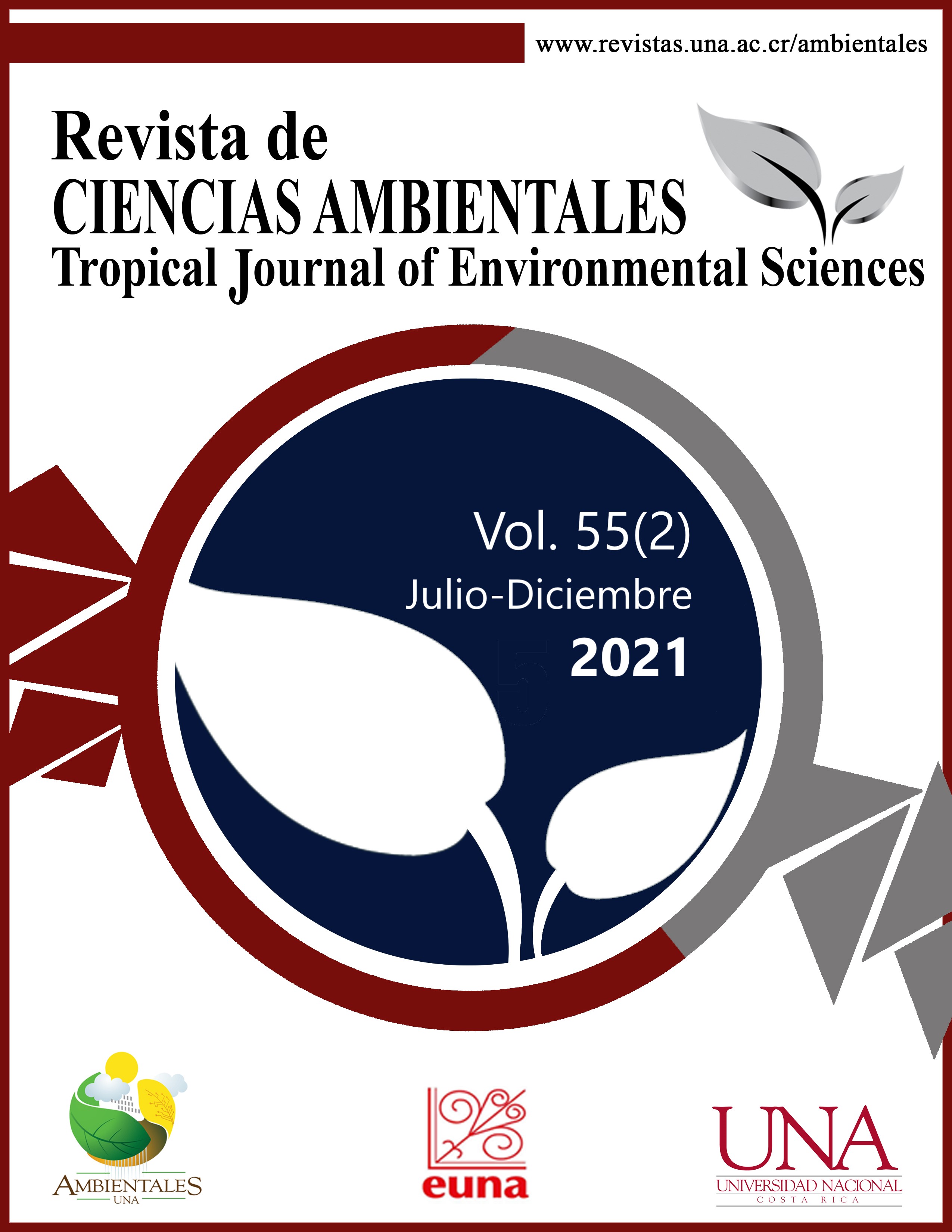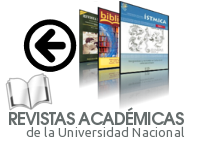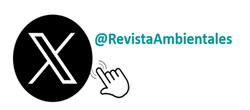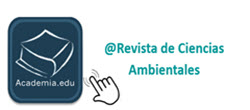Fluvial water quality perceptions in productive unit land managers of the Savegre river watershed, Costa Rica
DOI:
https://doi.org/10.15359/rca.55-2.4Keywords:
environmental cognitions, land management, rural landscape, Savegre Biosphere Reserve, watershedAbstract
[Introduction] The importance of understanding environmental cognitions for effective environmental management is increasingly recognized within sustainability science. Along with advancements in theorizations about cognitions in general and perceptions in particular, analyses of environmental cognitions in particular contexts are indispensable for effective environmental planning processes. [Objective] In this article, environmental perceptions of fluvial water quality and its associated threats are examined for 109 land managers from 15 communities in the Savegre river watershed in Costa Rica. [Methodology] Perceptions were captured through face-to-face surveys and analyzed through nonparametric statistical tests and ranking techniques. [Results] Environmental perceptions vary significantly among watershed sectors, ranges of distances to the river, types of primary productive activities, and formal education levels. Moreover, forest cover and environmental protection regimes are perceived as key factors favoring fluvial water quality. In contrast, the disfavoring factors and priority threats were almost entirely related to productive activities within the watershed, especially the expansion of the agricultural and cattle frontiers, aquaculture and destructive fishing, and agrochemical pollution. [Conclusions] It is concluded that, in this watershed, environmental perceptions about fluvial water quality are determined in large part by geographical and contextual factors, and that land managers show perceptual patterns suggesting recognition of ecological impacts of the same productive activities that have been taking place in the watershed for the last decades.
References
Acevedo, H., Bustamante, J., Paniagua, L., Chaves, R. (2002). Ecosistemas de la Cuenca Hidrográfica Del Río Savegre, Costa Rica. Editorial INBio.
Bremer, L. L., Farley, K. A., Lopez-Carr, D. (2014). What factors influence participation in payment for ecosystem services programs? An evaluation of Ecuador’s SocioPáramo program. Land Use Policy, 36(enero), 122–133. https://doi.org/10.1016/j.landusepol.2013.08.002
Brody, S. D., Highfield, W., Alston, L. (2004). Does location matter? Measuring environmental perceptions of creeks in two San Antonio watersheds. Environment and Behavior, 36(2), 229–250. https://doi.org/10.1177/0013916503256900
Burton, R. (2004). Reconceptualising the “behavioural approach” in agricultural studies: A socio-psychological perspective. Journal of Rural Studies, 20(3), 359–371. https://doi.org/10.1016/j.jrurstud.2003.12.001
Burton, R., Wilson, G. (2006). Injecting social psychology theory into conceptualisations of agricultural agency: Towards a post-productivist farmer self-identity? Journal of Rural Studies, 22(1), 95–115. https://doi.org/10.1016/j.jrurstud.2005.07.004
Chan, K. M. A., Balvanera, P., Benessaiah, K., Chapman, M., Diaz, S., Gómez-Baggethun, E., Gould, R., Hannahs, N., Jax, K., Klain, S., y otros. (2016). Why protect nature? Rethinking values and the environment. Proceedings of the National Academy of Sciences, 113(6), 1462–1465. https://doi.org/10.1073/pnas.1525002113
Clark, C. F., Kotchen, M. J., Moore, M. R. (2003). Internal and external influences on pro-environmental behavior: Participation in a green electricity program. Journal of Environmental Psychology, 23(3), 237–246. https://doi.org/10.1016/S0272-4944(02)00105-6
Clayton, S., y Saunders, C. (2012). Introduction: Environmental and conservation psychology. En S. Clayton (Ed.), The Oxford Handbook of Environmental and Conservation Psychology (pp. 1–10). Oxford University Press. https://doi.org/10.1093/oxfordhb/9780199733026.001.0001
Espinoza-Cisneros, E. (2020). Influence of Context-Specific Cognitions and Values on Pro-Environmental Land Management in the Rio Savegre Watershed, Costa Rica. Journal of Latin American Geography, 19(4), 235–263. https://doi.org/10.1353/lag.2020.0086
Espinoza-Cisneros, E. (2018). Optimizing social-ecological analysis of coupled human-river systems through the integration of conceptual frameworks: The case of the Savegre watershed, Costa Rica. Revista Geográfica de América Central, 61E(3), 32–50. https://doi.org/10.15359/rgac.61-3.3
Fitzsimons, J. A., Wescott, G. (2007). Perceptions and attitudes of land managers in multi-tenure reserve networks and the implications for conservation. Journal of Environmental Management, 84(1), 38–48. https://doi.org/10.1016/j.jenvman.2006.05.009
Gifford, R., Nilsson, A. (2014). Personal and social factors that influence pro-environmental concern and behaviour: A review. International Journal of Psychology, 49(3), 141–157. https://doi.org/10.1002/ijop.12034
Hines, J. M., Hungerford, H. R., Tomera, A. N. (1987). Analysis and synthesis of research on responsible environmental behavior: A meta-analysis. The Journal of Environmental Education, 18(2), 1–8. https://doi.org/10.1080/00958964.1987.9943482
Hukkinen, J. I. (2012). Fit in the Body: Matching Embodied Cognition with Social-Ecological Systems. Ecology and Society, 17(4). https://doi.org/10.5751/ES-05241-170430
Jacobs, S., Dendoncker, N., Martín-López, B., Barton, D. N., Gomez-Baggethun, E., Boeraeve, F., McGrath, F. L., Vierikko, K., Geneletti, D., Sevecke, K. J., y otros. (2016). A new valuation school: Integrating diverse values of nature in resource and land use decisions. Ecosystem Services, 22, 213–220. https://doi.org/10.1016/j.ecoser.2016.11.007
Jones, N., Shaw, S., Ross, H., Witt, K., Pinner, B. (2016). The study of human values in understanding and managing social-ecological systems. Ecology and Society, 21(1). https://doi.org/10.5751/ES-07977-210115
Kollmuss, A., Agyeman, J. (2002). Mind the Gap: Why do people act environmentally and what are the barriers to pro-environmental behavior? Environmental Education Research, 8(3), 239–260. https://doi.org/10.1080/13504620220145401
Larson, K. L., Santelmann, M. V. (2007). An Analysis of the Relationship between Residents’ Proximity to Water and Attitudes about Resource Protection. The Professional Geographer, 59(3), 316–333. https://doi.org/10.1111/j.1467-9272.2007.00615.x
Mattey, J. (2014). El proyecto Desarrollo Sostenible de la Cuenca Hidrográfica del Rio Savegre, una experiencia de desarrollo rural territorial. Ministerio de Agricultura y Ganadería (MAG) - Oficina Quepos, Costa Rica.
Meyfroidt, P. (2013). Environmental cognitions, land change, and social–ecological feedbacks: An overview. Journal of Land Use Science, 8(3), 341–367. https://doi.org/10.1080/1747423X.2012.667452
Ministerio de Ambiente y Energía y la Agencia Española de Cooperación Internacional [MINAE-AECI]. (2003). Plan de ordenamiento territorial de la cuenca hidrográfica del río Savegre [Documento técnico final]. San José, Costa Rica.
Naranjo, B. (2016). Ecología trófica de la trucha arcoíris Oncorhynchus mykiss (Salmonidae) en el Río Savegre, San Gerardo de Dota, Costa Rica. Tesis de licenciatura. Escuela de Biología - Universidad de Costa Rica.
Nassauer, J. (1995). Culture and changing landscape structure. Landscape Ecology, 10(4), 229–237. https://doi.org/10.1007/BF00129257
Price, J. C., Leviston, Z. (2014). Predicting pro-environmental agricultural practices: The social, psychological and contextual influences on land management. Journal of Rural Studies, 34, 65–78. https://doi.org/10.1016/j.jrurstud.2013.10.001
Prokopy, L. S., Floress, K., Arbuckle, J. G., Church, S. P., Eanes, F., Gao, Y., Gramig, B. M., Ranjan, P., Singh, A. S. (2019). Adoption of agricultural conservation practices in the United States: Evidence from 35 years of quantitative literature. Journal of Soil and Water Conservation, 74(5), 520–534. https://doi.org/10.2489/jswc.74.5.520
Rodríguez-Herrera, B. (2004). Distribución altitudinal, endemismo y conservación de mamíferos en la cuenca del río Savegre, Costa Rica. Brenesia, 61, 53–62.
Secretaría Ejecutiva de Planificación Sectorial Agropecuaria [SEPSA]. (2018). Situación de la afectación y daños causados por la Tormenta Nate al Sector Agropecuario y necesidades prioritarias (Decreto Ejecutivo N°40677-MP). San José, Costa Rica.
Sistema Nacional De Áreas de Conservación [SINAC]. (2017). Sistematización Desarrollo Sostenible de la Cuenca Hidrográfica del Río Savegre. Ministerio de Ambiente y Energía. San José, Costa Rica.
Soule, M. J., Tegene, A., Wiebe, K. D. (2000). Land tenure and the adoption of conservation practices. American Journal of Agricultural Economics, 82(4), 993–1005. https://doi.org/10.1111/0002-9092.00097
Verdugo, V. C., Fonllem, C. T., Armenta, M. F., Sing, B. F., González, D. (2009). Orientación a la sostenibilidad como base para el comportamiento pro-social y pro-ecológico. Medio Ambiente y Comportamiento Humano: Revista Internacional de Psicología Ambiental, 10(3), 195–215.
Published
How to Cite
Issue
Section
License

This work is licensed under a Creative Commons Attribution-NonCommercial-ShareAlike 4.0 International License.



















